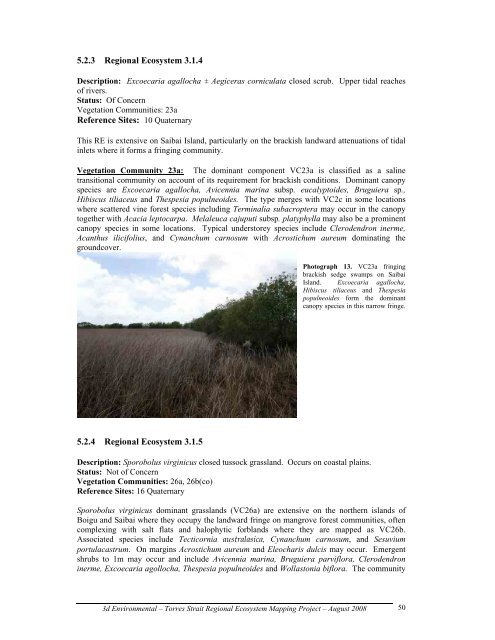Appendix 2 - Vegetation Communities and Regional Ecosystems
Appendix 2 - Vegetation Communities and Regional Ecosystems
Appendix 2 - Vegetation Communities and Regional Ecosystems
You also want an ePaper? Increase the reach of your titles
YUMPU automatically turns print PDFs into web optimized ePapers that Google loves.
5.2.3 <strong>Regional</strong> Ecosystem 3.1.4<br />
Description: Excoecaria agallocha ± Aegiceras corniculata closed scrub. Upper tidal reaches<br />
of rivers.<br />
Status: Of Concern<br />
<strong>Vegetation</strong> <strong>Communities</strong>: 23a<br />
Reference Sites: 10 Quaternary<br />
This RE is extensive on Saibai Isl<strong>and</strong>, particularly on the brackish l<strong>and</strong>ward attenuations of tidal<br />
inlets where it forms a fringing community.<br />
<strong>Vegetation</strong> Community 23a: The dominant component VC23a is classified as a saline<br />
transitional community on account of its requirement for brackish conditions. Dominant canopy<br />
species are Excoecaria agallocha, Avicennia marina subsp. eucalyptoides, Bruguiera sp.,<br />
Hibiscus tiliaceus <strong>and</strong> Thespesia populneoides. The type merges with VC2c in some locations<br />
where scattered vine forest species including Terminalia subacroptera may occur in the canopy<br />
together with Acacia leptocarpa. Melaleuca cajuputi subsp. platyphylla may also be a prominent<br />
canopy species in some locations. Typical understorey species include Clerodendron inerme,<br />
Acanthus ilicifolius, <strong>and</strong> Cynanchum carnosum with Acrostichum aureum dominating the<br />
groundcover.<br />
5.2.4 <strong>Regional</strong> Ecosystem 3.1.5<br />
Photograph 13. VC23a fringing<br />
brackish sedge swamps on Saibai<br />
Isl<strong>and</strong>. Excoecaria agallocha,<br />
Hibiscus tiliaceus <strong>and</strong> Thespesia<br />
populneoides form the dominant<br />
canopy species in this narrow fringe.<br />
Description: Sporobolus virginicus closed tussock grassl<strong>and</strong>. Occurs on coastal plains.<br />
Status: Not of Concern<br />
<strong>Vegetation</strong> <strong>Communities</strong>: 26a, 26b(co)<br />
Reference Sites: 16 Quaternary<br />
Sporobolus virginicus dominant grassl<strong>and</strong>s (VC26a) are extensive on the northern isl<strong>and</strong>s of<br />
Boigu <strong>and</strong> Saibai where they occupy the l<strong>and</strong>ward fringe on mangrove forest communities, often<br />
complexing with salt flats <strong>and</strong> halophytic forbl<strong>and</strong>s where they are mapped as VC26b.<br />
Associated species include Tecticornia australasica, Cynanchum carnosum, <strong>and</strong> Sesuvium<br />
portulacastrum. On margins Acrostichum aureum <strong>and</strong> Eleocharis dulcis may occur. Emergent<br />
shrubs to 1m may occur <strong>and</strong> include Avicennia marina, Bruguiera parviflora, Clerodendron<br />
inerme, Excoecaria agollocha, Thespesia populneoides <strong>and</strong> Wollastonia biflora. The community<br />
3d Environmental – Torres Strait <strong>Regional</strong> Ecosystem Mapping Project – August 2008<br />
50


